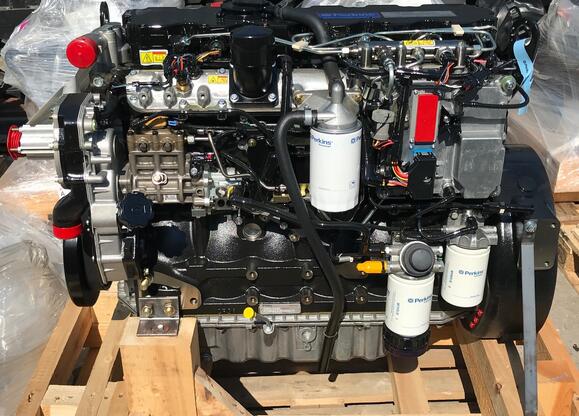This instruction show you guide on how to repair Perkins 1106D electric power generation (EPG) cranks but will not start with high press fuel system trouble.

Preparations:
Perkins EST 2024A & 2023A & 2019A Software Free Download
Perkins SPI2 2018A EPC+Service Manual Free Download
Procedures:
1.Use the Perkins electronic service tool to check the absolute fuel rail pressure while the engine is cranking at a minimum speed of 150 rpm.
2.If the absolute fuel rail pressure is less than 25 MPa (3625 psi), perform the following
procedure:
a.Check that the inlet pressure at the fuel rail pump is greater than 50 kPa (7.25 psi). If the inlet pressure is less than 50 kPa (7.25 psi),repeat the diagnostic process from “Low Pressure Fuel System”.
b.Check for fuel leaks in the high pressure fuel system. Rectify any fuel leaks and then recheck the pressure in the fuel rail. If the fuel rail pressure is greater than 25 MPa (3625 psi),proceed to test step 3.
c.Use the electronic service tool to perform a solenoid test on the fuel rail pump. Refer to Troubleshooting, “Fuel Rail Pump Solenoid -Test”.
d.If any service has been performed as a result of Step 2.c, attempt to start the engine. If the engine will not start, repeat the diagnostic process from “Diagnostic Codes”.
e.Check the pressure relief valve in the fuel rail for leakage. If the pressure relief valve is leaking, replace the valve and recheck the pressure in the fuel rail.
f.If the pressure relief valve in the fuel rail is not leaking, check for fuel in the engine oil system. If fuel is suspected in the oil system,take an engine oil sample for analysis. Refer to Operation and Maintenance Manual, “Engine Oil Sample – Obtain”. If the analysis confirms that there is fuel in the engine oil system,investigate the cause.
g.If fuel is not found in the oil system, check the electronic unit injectors for excessive fuel leak off.
h.If the leak off is greater than 38 mL (1.3 oz) in 30 seconds for a 6 cylinder engine or the leak off is greater than 25 mL (0.85 oz) in 30 seconds for a 4 cylinder engine, replace the electronic unit injectors.
Note: The fault is not in the fuel rail pump. Do not replace the pump.
i.If the leak off is less than 38 mL (1.3 oz) in 30 seconds for a 6 cylinder engine or the leak off is less than 25 mL (0.85 oz) in 30 seconds for a 4 cylinder engine, proceed to Test Step 3.d.
3.If the absolute fuel rail pressure is greater than 25 MPa (3625 psi), perform the following procedure:
a.Use the electronic service tool to make sure that the status of the electronic unit injectors is not “Disabled”. If the injectors are disabled but the injectors were not intentionally disabled
with the electronic service tool, proceed to test step 3.d.
b.If the electronic unit injectors are not disabled,use the electronic service tool to perform an injector solenoid test. Refer to Troubleshooting,“Injector Solenoid Circuit – Test”.
c.If any service has been performed as a result of Step 3.b, attempt to start the engine. If the engine will not start, proceed to “Glow Plugs”.
d.Make sure that the latest flash file for the application is installed in the ECM. Refer to Troubleshooting, “Flash Programming”.
e.Contact Perkins Global Technical Support.
Note: This consultation can greatly reduce the repair time.
f.If Perkins Global Technical Support recommends the use of a test ECM, install a test ECM. Refer to Troubleshooting, “Replacing the ECM”.
g.Attempt to start the engine. If the engine will not start, install the original ECM and then proceed to Test Step 3.l.
h.If the engine starts normally, stop the engine and then attempt to start the engine again. If the engine will not start at the second attempt,proceed to Test Step 3.k.
If the engine starts normally, reconnect the suspect ECM and then verify that the fault returns when the suspect ECM is installed.
j.If the engine will not start with the suspect ECM, replace the ECM. Check that the engine starts normally. If the engine starts normally, no further testing is required.
k.Replace the ECM again and then replace the fuel rail pump. Verify that the fault has been eliminated. If the engine will not start, proceed to “Glow Plugs”.
l.Check the timing of the fuel rail pump. Refer to Systems Operation, Testing and Adjusting, “Fuel Injection Timing – Check”.
m.If the timing of the fuel rail pump required adjustment and the engine will not start,proceed to “Glow Plugs”.
n.If the timing of the fuel rail pump was correct,replace the fuel rail pump. If the engine will not start, proceed to “Glow Plugs”
Glow Plugs
Note: Faulty glow plugs will only affect engine starting when the ambient temperature is below 10 °C (50 °F).
1.Check the operation of the glow plugs.
2.If necessary, replace faulty glow plugs.
3.Attempt to start the engine. If the engine will not start, proceed to “Valve Lash”
More Perkins case,please refer to:Perkins Engine Trouble Repair